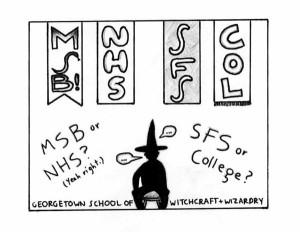On its Web site, Georgetown College boasts that it offers over 100,000 possible combinations of majors and minors – not bad. But all the undergraduate schools of the university could expand academic freedom for students if they gave one simple policy a try.
As higher education has grown generally more liberal over the past several decades, universities across the country have implemented undergraduate “dual degree” programs, in which students are able to receive degrees from two different schools within single universities. These programs ostensibly aim to give students academic flexibility.
For the most part, however, Georgetown offers no comparable options. The university doesn’t do enough to accommodate students who want to venture outside of their respective schools.
Of course, it is possible for students in the College majoring in the liberal arts to also follow a pre-med curriculum, just like chemistry majors. Students in the Faculty of Languages and Linguistics can major in business, as well. There are some options for students in other schools to minor in the College, and for College students to pursue certificates offered by the School of Foreign Service.
On the other hand, Washington University in St. Louis offers students the option of simultaneously seeking full degrees in its College of Arts & Sciences and its School of Engineering. The College of Arts and Sciences at Cornell University allows its students to pursue degrees at three other undergraduate colleges within the university.
The invisible barriers among the four undergraduate schools of Georgetown foreclose the option of majoring across disciplinary lines. This prevents academic cross-pollination at Georgetown and restricts students’ intellectual freedom.
The university should allow some students to seek second degrees in other schools. This would dramatically increase the number of academic options, entice applicants reluctant to commit to a single discipline, promote consideration of alternative careers and heighten intellectual discourse on campus. Students from the four schools often share core classes and space; the administration should allow some overlapping to occur in degree programs as well.
Faculty and advising resources do constrain the university’s ability to offer cross-school dual degrees – simply opening up the process would put a considerable strain on faculty and staff. Without a few conditions, this would be completely unworkable.
Students who wish to pursue a major in another school should therefore be required to apply to the dean’s office of that school through a formal process. This would allow the school to determine how many and which students it could accommodate. The process might look something like the arrangement for School of Foreign Service students who are declaring their majors, which involves an essay and a discussion with a dean.
Upper-level courses still pose a problem. The small size of many upper-level classes allows students greater access to faculty. Under a dual-degree program, some departments might be unreasonably pressured to meet increased demand from students with declared majors.
To address this problem, academic departments could choose not to guarantee degree opportunities to students from other schools. Those students could be allowed to enroll in courses and attempt to enter top-level courses with no guarantee; if they managed to complete all requirements for the major, they would naturally receive a second diploma.
We acknowledge the logistical problems that prevent the wholesale opening of academic barriers among the schools. But permission to pursue degrees in schools other than their own would pay dividends for students as they apply to graduate school and consider careers. We encourage Georgetown to consider embracing this program – if done correctly, it would refresh academic life in a novel way.
To send a letter to the editor on a recent campus issue or Hoya story or a viewpoint on any topic, contact opinionthehoya.com. Letters should not exceed 300 words, and viewpoints should be between 600 to 800 words.
“







